 Happy St. Patrick’s Day! My recently released, curated collection of fiddle tunes is currently on sale at Amazon. You can also grab a PDF copy right away via download purchase.
Happy St. Patrick’s Day! My recently released, curated collection of fiddle tunes is currently on sale at Amazon. You can also grab a PDF copy right away via download purchase.
 I put together this Fiddle Fundamentals Folio book to answer the question: “Why play etudes when you can play fiddle tunes?” Introducing fiddle tunes into students’ (or your own) etude practice builds finger dexterity, bowing agility, and sight reading skills while also being FUN! I collected 40 toe-tapping traditional fiddle tunes and arranged them by key signature and sequential difficulty, from beginning to advanced levels. First-position-only tunes can be played slow to fast while focusing on the following technical skills:
I put together this Fiddle Fundamentals Folio book to answer the question: “Why play etudes when you can play fiddle tunes?” Introducing fiddle tunes into students’ (or your own) etude practice builds finger dexterity, bowing agility, and sight reading skills while also being FUN! I collected 40 toe-tapping traditional fiddle tunes and arranged them by key signature and sequential difficulty, from beginning to advanced levels. First-position-only tunes can be played slow to fast while focusing on the following technical skills:
Finger Dexterity: Fiddle tunes require rapid finger action on one or two strings. Ornamentations increase the speed of finger dropping-and-lifting and can train a light, tension-free touch. Students can learn preparatory double-stop technique through the focus on “quiet fingers” that stay put as long as possible. Guidance for turning tunes into finger exercises will get fingers flying faster and more accurately in no time!
Bowing Agility: Use fiddle tunes to focus on left side/right side coordination. The characteristic rapid string changes and off-beat slurs call for a relaxed, flexible technique and mindset.
 Sightreading: Fiddle tunes can be deceptively simple to play at sight. The trick is in maintaining full-speed tempos, bowings, and ornaments while always reading at least one note ahead. The 40 tunes in this book will provide lots of fresh music to play, and resources are included to find even more.
Sightreading: Fiddle tunes can be deceptively simple to play at sight. The trick is in maintaining full-speed tempos, bowings, and ornaments while always reading at least one note ahead. The 40 tunes in this book will provide lots of fresh music to play, and resources are included to find even more.
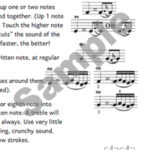 Improvisation: Traditional techniques for adding slurs and ornaments allow the musician to play a tune differently each time. Preparatory scales and arpeggios are provided for each key, with introductory chord theory and chords for every tune, to help bridge players towards harmonic and chordal improvisation.
Improvisation: Traditional techniques for adding slurs and ornaments allow the musician to play a tune differently each time. Preparatory scales and arpeggios are provided for each key, with introductory chord theory and chords for every tune, to help bridge players towards harmonic and chordal improvisation.
Here’s the table of contents.
If you can’t wait to get your hands on some tunes to play this weekend, you can purchase a PDF copy below. It doesn’t have a fancy cover like the book you can buy on Amazon, but the inside looks exactly the same! I would love to hear your comments after you’ve used the book! Sláinte!
Download “Fiddle Fundamentals Folio” PDF for $8.50
or Purchase bound book version on Amazon


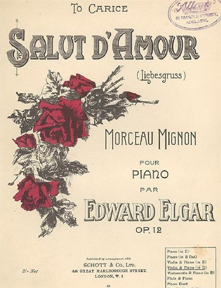 Salut d’Amour, a salon piece by Edward Elgar, is a favorite for students who enjoy its unabashedly romantic vibe and mandatory expressive shifting. I place it at advanced-intermediate Level 6, where it is technically comparable to the Accolay Concerto or Haydn Concerto in G. I teach the version in the original key of E, not transposed to D which is also available. Because Salut d’Amour is in the public domain (published in 1899), early editions in both D and E are freely available on sheet music websites like IMSLP.org.
Salut d’Amour, a salon piece by Edward Elgar, is a favorite for students who enjoy its unabashedly romantic vibe and mandatory expressive shifting. I place it at advanced-intermediate Level 6, where it is technically comparable to the Accolay Concerto or Haydn Concerto in G. I teach the version in the original key of E, not transposed to D which is also available. Because Salut d’Amour is in the public domain (published in 1899), early editions in both D and E are freely available on sheet music websites like IMSLP.org.
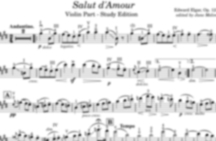
 Is this the opening of the most overplayed piece in the violin repertoire? Probably! Does that mean that violin students should not have an opportunity to learn this Greatest Hit of Classical Music for themselves? Of course not! If piano teachers can keep teaching Für Elise, we can keep teaching The Pachelbel!
Is this the opening of the most overplayed piece in the violin repertoire? Probably! Does that mean that violin students should not have an opportunity to learn this Greatest Hit of Classical Music for themselves? Of course not! If piano teachers can keep teaching Für Elise, we can keep teaching The Pachelbel! My students GET to learn The Pachelbel when they reach the equivalent of Suzuki Book 4. And most of them LOVE it. Many transferable skills can be taught using this piece: Counting in 8/8, note values from dotted-quarter-notes to thirty-second-notes, a little bit of 3rd position shifting, ensemble playing with two other partners, even Baroque performance practice if desired.
My students GET to learn The Pachelbel when they reach the equivalent of Suzuki Book 4. And most of them LOVE it. Many transferable skills can be taught using this piece: Counting in 8/8, note values from dotted-quarter-notes to thirty-second-notes, a little bit of 3rd position shifting, ensemble playing with two other partners, even Baroque performance practice if desired.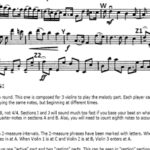
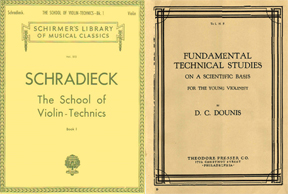

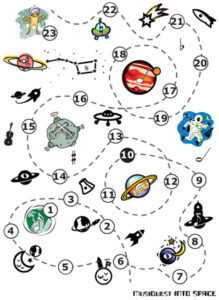 My second incentive program theme is literally Out Of This World! You could also call it Space, The Final Frontier; Into Space; or even Blast Off! I get ideas for my incentive programs from the variety of economy-priced awards I can purchase from
My second incentive program theme is literally Out Of This World! You could also call it Space, The Final Frontier; Into Space; or even Blast Off! I get ideas for my incentive programs from the variety of economy-priced awards I can purchase from 
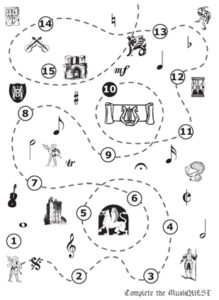 The first
The first  A Do-It-Yourself S’mores Kit is my “teacher’s choice” award for my best practicers at the year-end recital.
A Do-It-Yourself S’mores Kit is my “teacher’s choice” award for my best practicers at the year-end recital.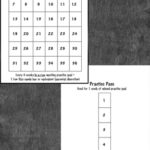 Students who met their
Students who met their  I top it off with a punny label like this one. Here’s a
I top it off with a punny label like this one. Here’s a